

Compact Muon Solenoid
LHC, CERN
| CMS-PAS-EXO-17-022 | ||
| A search for light pair-produced resonances decaying into at least four quarks | ||
| CMS Collaboration | ||
| March 2018 | ||
| Abstract: Results are presented of a search for light pair-produced particles that each decay into at least four quarks, targeting particles with masses above 100 GeV. The representative signal model is a supersymmetric quark that decays into four quarks through an intermediate Higgsino with a hadronic $R$-parity-violating coupling. Using 38.2 fb$^{-1}$ of data collected by the CMS experiment at the LHC from 2015 to 2016 with proton-proton collisions at a center-of-mass energy $\sqrt{s}= $ 13 TeV, reconstructed particles are clustered into two jets with large radius and high transverse momentum, each consistent with four-parton substructure and with similar mass. A novel, data-driven technique is used to estimate the dominant QCD multijet event background. Background contributions from top-quark decays are also taken into account and additionally serve for the calibration of systematic uncertainties. No statistically significant excess is observed, and the production of supersymmetric quark pairs and supersymmetric gluon pairs with masses below 721 GeV and 1.0 TeV, respectively, are excluded at the 95% confidence level. | ||
|
Links:
CDS record (PDF) ;
CADI line (restricted) ;
These preliminary results are superseded in this paper, PRL 121 (2018) 141802. The superseded preliminary plots can be found here. |
||
| Figures | |
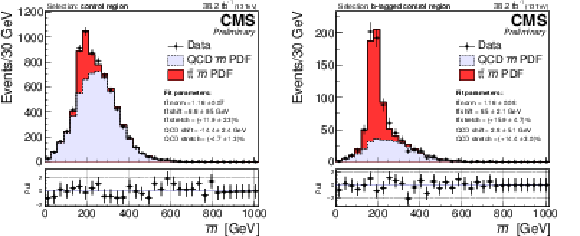
png pdf |
Figure 1:
The background estimation results in the control region (left) and b-tagged control region (right). The relevant fit parameters are displayed on each plot. |
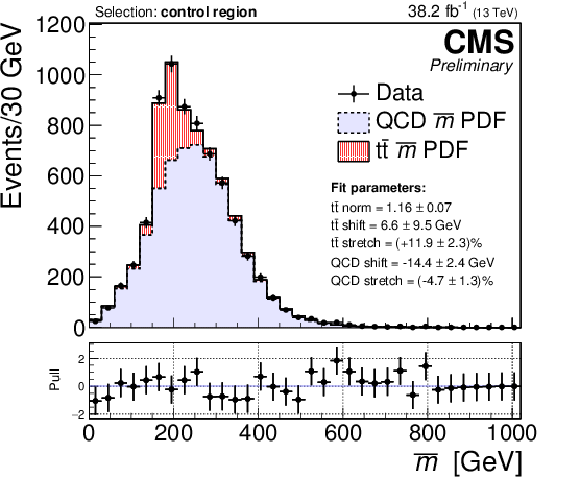
png pdf |
Figure 1-a:
The background estimation results in the control region (left) and b-tagged control region (right). The relevant fit parameters are displayed on each plot. |

png pdf |
Figure 1-b:
The background estimation results in the control region (left) and b-tagged control region (right). The relevant fit parameters are displayed on each plot. |

png pdf |
Figure 2:
Left: the $m$ distribution of the tagged $ {p_{\mathrm {T}}} $-leading fatjets $P(m)$ in the signal region and the $ {\overline {m}} $ PDFs derived from these fatjets with and without $ {H_{\mathrm {T}}} $ re-weighting. Right: a comparison between the QCD multijet $ {\overline {m}} $ PDF and the tagged fatjet pair selection in simulated QCD multijet events that pass the signal selection. |

png pdf |
Figure 2-a:
Left: the $m$ distribution of the tagged $ {p_{\mathrm {T}}} $-leading fatjets $P(m)$ in the signal region and the $ {\overline {m}} $ PDFs derived from these fatjets with and without $ {H_{\mathrm {T}}} $ re-weighting. Right: a comparison between the QCD multijet $ {\overline {m}} $ PDF and the tagged fatjet pair selection in simulated QCD multijet events that pass the signal selection. |
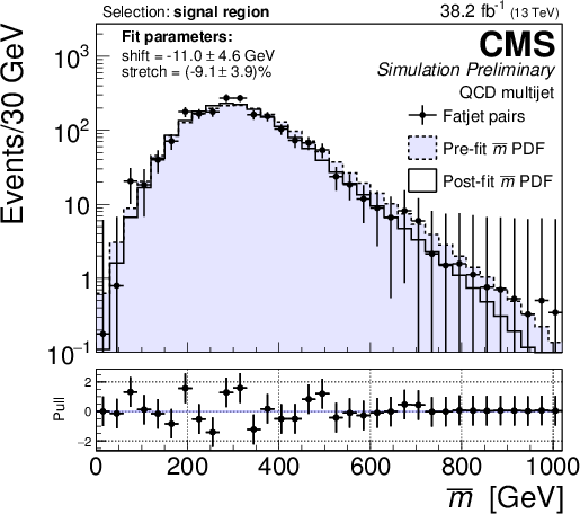
png pdf |
Figure 2-b:
Left: the $m$ distribution of the tagged $ {p_{\mathrm {T}}} $-leading fatjets $P(m)$ in the signal region and the $ {\overline {m}} $ PDFs derived from these fatjets with and without $ {H_{\mathrm {T}}} $ re-weighting. Right: a comparison between the QCD multijet $ {\overline {m}} $ PDF and the tagged fatjet pair selection in simulated QCD multijet events that pass the signal selection. |
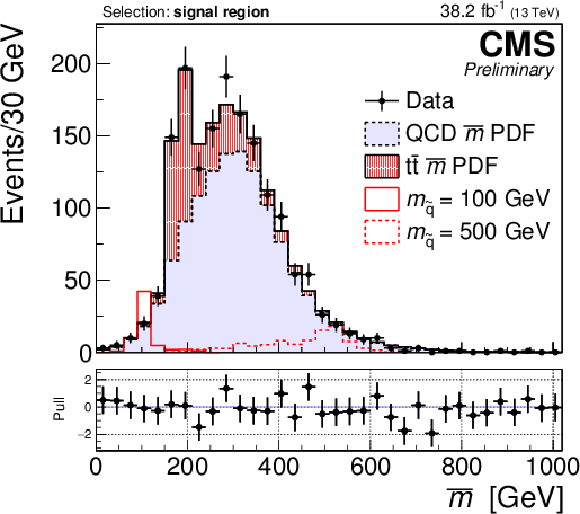
png pdf |
Figure 3:
Distributions in $ {\overline {m}} $ and the predicted background contributions. Shown also are the signal expected from a squark with masses of 100 and 500 GeV. |

png pdf |
Figure 4:
The expected and observed limits on the squark (left) and gluino (right) signal production. |

png pdf |
Figure 4-a:
The expected and observed limits on the squark (left) and gluino (right) signal production. |

png pdf |
Figure 4-b:
The expected and observed limits on the squark (left) and gluino (right) signal production. |
| Tables | |
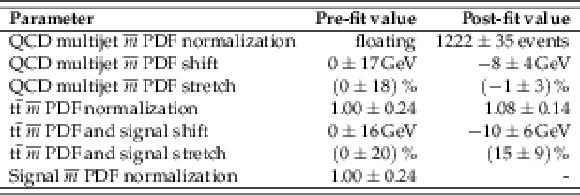
png pdf |
Table 1:
The nuisance parameters corresponding to each rate and shape parameter of the background and signal distributions before and after the statistical fit. Except for the QCD multijet $ {\overline {m}} $ PDF normalization, which is floating (and whose value is simply the event yield with statistical uncertainty), each nuisance parameter has a Gaussian PDF and is reported as its mean $\pm $ its standard deviation. |
| Summary |
| In summary, a search was conducted for light pair-produced resonances that decay into at least four quarks. No statistically significant excess over standard model expectations was observed. The data impose limits on RPV SUSY [13] pair production, excluding squark masses between 100 and 721 GeV and gluino masses between 0.10 and 1.0 TeV. This is the first time that constraints have been placed on pair-produced particles decaying into four or five quarks in this mass range, covering a significant gap in the parameter space of RPV SUSY. This analysis is sufficiently general that other models of strongly produced particles decaying into four or more detector-visible objects are also likely to be constrained. |
| References | ||||
| 1 | R. Barbieri, S. Ferrara, and C. A. Savoy | Gauge models with spontaneously broken local supersymmetry | PLB 119 (1982) 343 | |
| 2 | J. Wess and B. Zumino | Supergauge transformations in four dimensions | NPB 70 (1974) 39 | |
| 3 | Y. A. Gol'fand and E. P. Likhtman | Extension of the algebra of poincar$ \'e $ group generators and violation of p invariance | JEPTL 13 (1971) 323 | |
| 4 | D. V. Volkov and V. P. Akulov | Possible universal neutrino interaction | JEPTL 16 (1972) 438 | |
| 5 | A. H. Chamseddine, R. L. Arnowitt, and P. Nath | Locally supersymmetric grand unification | PRL 49 (1982) 970 | |
| 6 | G. L. Kane, C. F. Kolda, L. Roszkowski, and J. D. Wells | Study of constrained minimal supersymmetry | PRD 49 (1994) 6173 | hep-ph/9312272 |
| 7 | P. Fayet | Supergauge invariant extension of the higgs mechanism and a model for the electron and its neutrino | NPB 90 (1975) 104 | |
| 8 | L. J. Hall, J. D. Lykken, and S. Weinberg | Supergravity as the messenger of supersymmetry breaking | PRD 27 (1983) 2359 | |
| 9 | P. Ramond | Dual theory for free fermions | PRD 3 (1971) 2415 | |
| 10 | R. Kitano and Y. Nomura | Supersymmetry, naturalness, and signatures at the LHC | PRD73 (2006) 095004 | hep-ph/0602096 |
| 11 | C. Brust, A. Katz, S. Lawrence, and R. Sundrum | SUSY, the Third Generation and the LHC | JHEP 03 (2012) 103 | 1110.6670 |
| 12 | M. Papucci, J. T. Ruderman, and A. Weiler | Natural susy endures | JHEP 09 (2012) 035 | |
| 13 | J. A. Evans and Y. Kats | LHC coverage of RPV MSSM with light stops | JHEP 04 (2013) 028 | |
| 14 | R. Barbier et al. | R-parity-violating supersymmetry | Physics Reports 420 (2005) 1 | |
| 15 | CMS Collaboration | Search for new phenomena in events with high jet multiplicity and low missing transverse momentum in proton-proton collisions at $ \sqrt{s}= $ 8 ~TeV | PLB 770 (2017) 257 | CMS-EXO-13-001 1608.01224 |
| 16 | CMS Collaboration | Searches for $ r $-parity-violating supersymmetry in pp collisions at $ \sqrt{s}= $ 8 ~tev in final states with 0--4 leptons | PRD 94 (2016) 112009 | CMS-SUS-14-003 1606.08076 |
| 17 | ATLAS Collaboration | Search for new phenomena in final states with large jet multiplicities and missing transverse momentum with ATLAS using $ \sqrt{s}= $ 13 ~TeV proton-proton collisions | PLB 757 (2016) 334 | 1602.06194 |
| 18 | ATLAS Collaboration | Search for massive supersymmetric particles decaying to many jets using the ATLAS detector in pp collisions at $ \sqrt{s}= $ 8 ~TeV | PRD 91 (2015) 112016 | 1502.05686 |
| 19 | CMS Collaboration | Search for low mass vector resonances decaying into quark-antiquark pairs in proton-proton collisions at $ \sqrt{s}= $ 13 ~TeV | JHEP 01 (2018) 097 | CMS-EXO-17-001 1710.00159 |
| 20 | ATLAS Collaboration | A search for pair-produced resonances in four-jet final states at $ \sqrt{s} = $ 13 TeV with the ATLAS detector | 1710.07171 | |
| 21 | CMS Collaboration | Search for pair-produced resonances decaying to jet pairs in proton-proton collisions at $ \sqrt{s}= $ 8 ~TeV | PLB 747 (2015) 98 | CMS-EXO-12-052 1412.7706 |
| 22 | ATLAS Collaboration | A search for top squarks with r-parity-violating decays to all-hadronic final states with the ATLAS detector in $ \sqrt{s}= $ 8 ~TeV proton-proton collisions | JHEP 6 (2016) 67 | 1601.07453 |
| 23 | CMS Collaboration | Particle-flow reconstruction and global event description with the CMS detector | JINST 12 (2017) P10003 | CMS-PRF-14-001 1706.04965 |
| 24 | CMS Collaboration | The CMS experiment at the CERN LHC | Journal of Instrumentation 3 (2008) S08004 | CMS-00-001 |
| 25 | G. P. Salam | Towards jetography | The European Physical Journal C 67 (2010) 637 | hep-ph/10906.1833 |
| 26 | J. Alwall and et al. | The automated computation of tree-level and next-to-leading order differential cross sections, and their matching to parton shower simulations | JHEP 7 (2014) 79 | 1405.0301 |
| 27 | N. Collaboration | Parton distributions with LHC data | NPB 867 (2013) 244 | 1207.1303 |
| 28 | T. Sjostrand, S. Mrenna, and P. Skands | A brief introduction to PYTHIA 8.1 | Computer Physics Communications 178 (2008) 852 | 0710.3820 |
| 29 | C. Borschensky et al. | Squark and gluino production cross sections in pp collisions at $ \sqrt{s}= $ 13 , 14, 33 and 100~TeV | EPJD 74 (2014) 3174 | |
| 30 | S. Frixione, P. Nason, and C. Oleari | Matching NLO QCD computations with parton shower simulations: the POWHEG method | JHEP 11 (2007) 70 | 0709.2092 |
| 31 | CMS Collaboration Collaboration | Measurement of differential cross sections for top quark pair production using the $ \text{lepton}+\text{jets} $ final state in proton-proton collisions at 13~TeV | PRD 95 (May, 2017) 092001 | |
| 32 | M. Cacciari, G. P. Salam, and G. Soyez | FastJet user manual | The European Physical Journal C 72 (2012), no. 3 | 1111.6097 |
| 33 | CMS Collaboration | Jet algorithms performance in 13~TeV data | CMS-PAS-JME-16-003 | CMS-PAS-JME-16-003 |
| 34 | J. Thaler and K. Van Tilburg | Maximizing boosted top identification by minimizing N-subjettiness | JHEP 2 (2012) 93 | 1108.2701 |
| 35 | S. D. Ellis, C. K. Vermilion, and J. R. Walsh | Recombination algorithms and jet substructure: pruning as a tool for heavy particle searches | PRD 81 (2010) 094023 | 0912.0033 |
| 36 | CMS Collaboration | Identification of heavy-flavour jets with the CMS detector in pp collisions at 13 TeV | Submitted to \it JINST | CMS-BTV-16-002 1712.07158 |
| 37 | G. Cowan, ``Statistics'', Ch. 39 in Particle Data Group, C. Patrignani et al. | Statistics'', Ch. 39 in Particle Data Group, C.~Patrignani et~al., ``Review of particle physics | CPC 40 (2016) 100001 | |

|
Compact Muon Solenoid LHC, CERN |

|

|

|

|

|

|